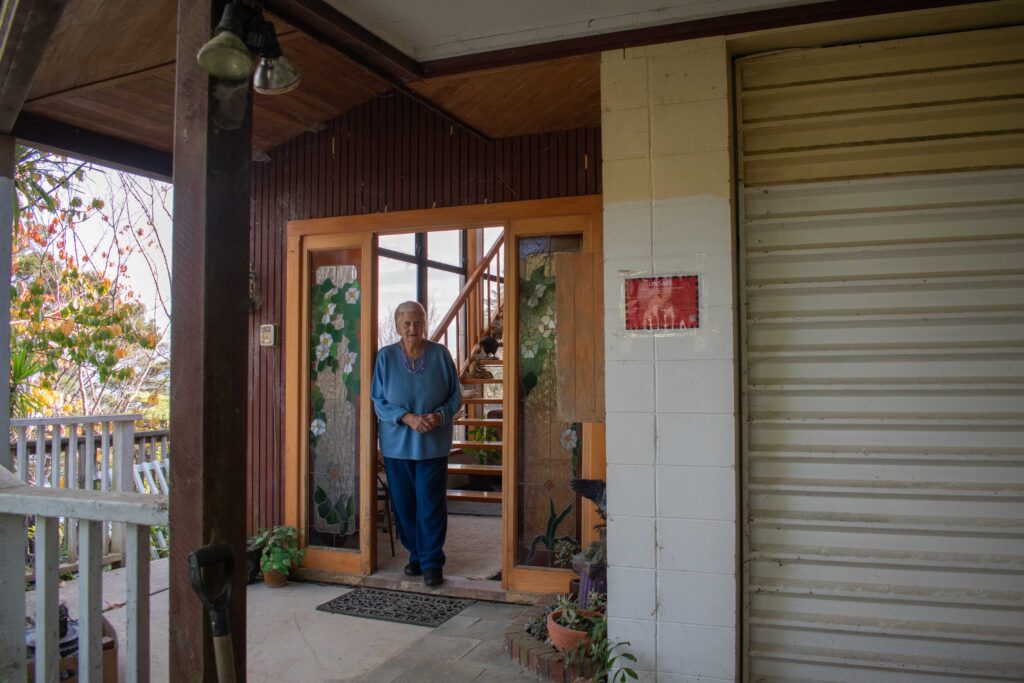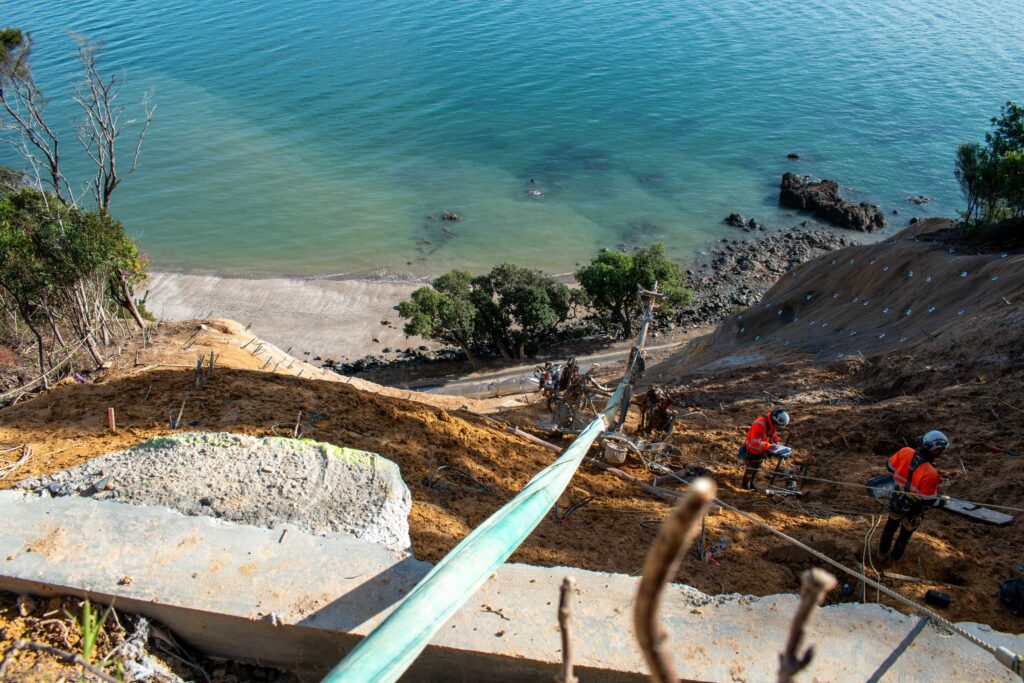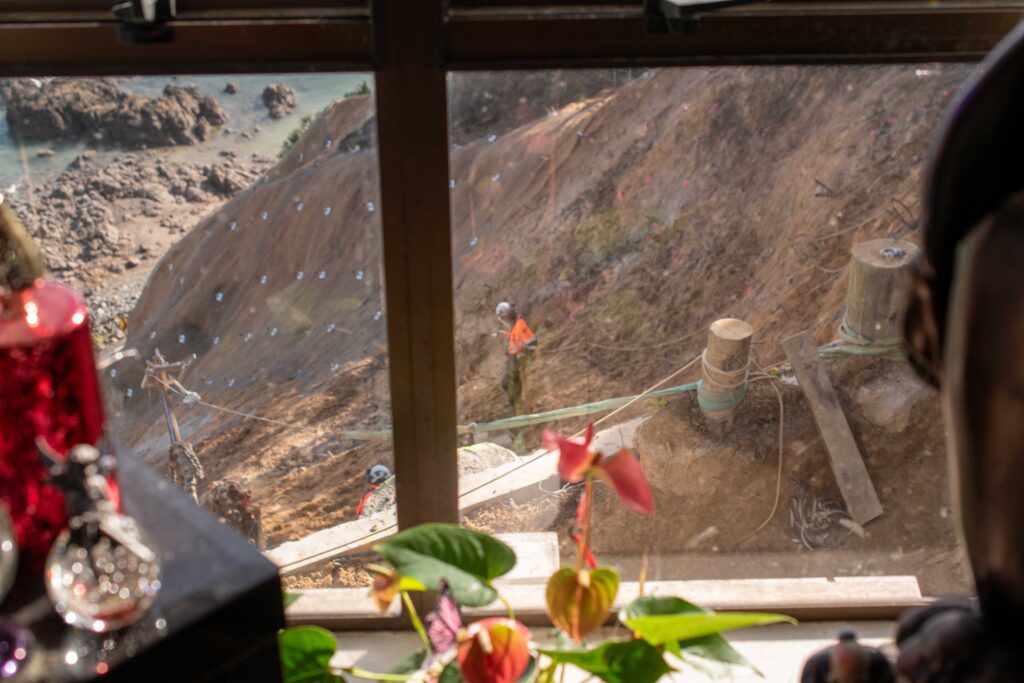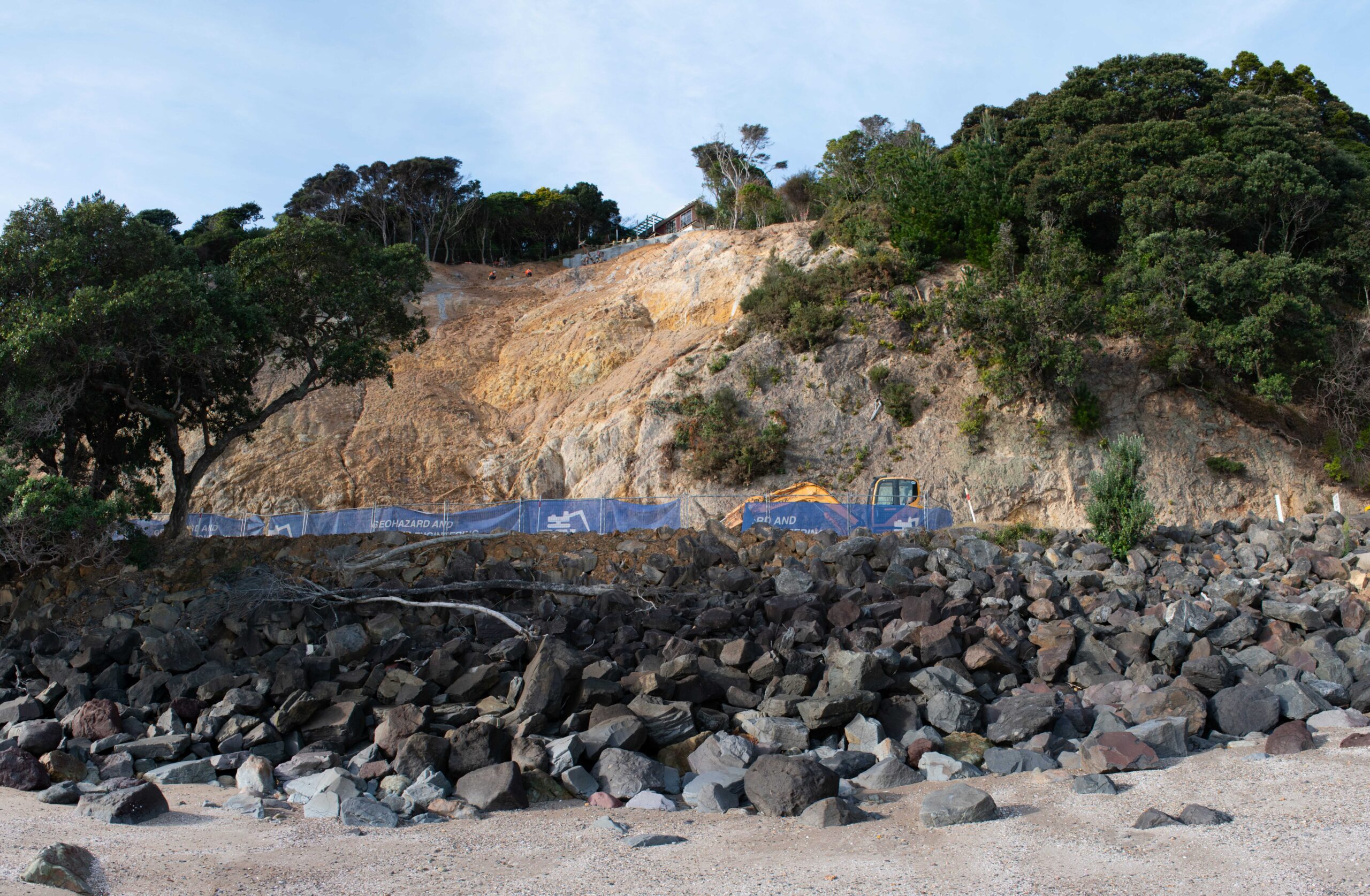The Thames Coromandel region is slowly recovering from severe damage caused by storms in the summer of 2023. The Kōpū-Hikuai road has been repaired, tourists are coming back to the peninsula and life is returning to normal for most. For a handful of residents though, the devastation has left them locked in limbo. In the first of a series of articles investigating life for those with red-stickered homes, reporter ALICE PARMINTER speaks to a resident perched on the edge of the Ruamahanga Bay slip.
Perched on a recliner in her second-story lounge, Gale Carlson feels as though she’s aboard a ship in the ocean.
The 84-year-old has lived in the cliff-top home in Ruamahunga Bay for 45 years. An expansive tree-covered section once separated her home from the highway below, but over the years it has been slipping away in pieces.
Now, the house teeters on the very edge of the cliff. The upstairs ranch slider is boarded shut for safety and the sea-facing verandah has been partially removed. What’s left of the deck dangles over the orange-clad construction workers who hang from the cliff face each day, installing concrete and soil nails to stabilise the slip. The space between the house and the slip is barely wide enough for a vehicle, and cracks between the concrete path and the exterior walls are visible reminders of the home’s instability.
But despite the issues – and an R2 red sticker declaring the property unsafe during storm events – Gale is still here.
“I’m not bloody well going,” she recalled saying to a police officer who came to escort her off the property last year.
“There was no way I was going to leave my house [again]. Well, I’m still here and I feel quite safe. I just keep looking at the cracks in the ceiling, and when they start to move too much I’ll be staggering up the passage and out the back window.”
RED STICKERED HOMES
A red sticker or placard is a legal notice placed on a property deemed unsafe to enter. There are two types of red stickers: R1, indicating damage to the building structure itself; and R2, where a building is at risk of being affected by an external hazard. Red stickers can only be removed by the territorial authority after appropriate work has been undertaken and the building has been reassessed.
There are currently eight properties with red stickers in the Thames Coromandel district. A further 25 properties are yellow-stickered, indicating access is restricted.
Thames Coromandel District Council said there were initially 19 red-stickered and 27 yellow-stickered properties following the 2023 cyclones.
“Our council has been working closely with the affected property owners to support them as they navigate the Earthquake Commission and insurance claims processes. This includes providing technical advice and support from our building staff, as well as social support and wrap-around services,” council said.
Housing support immediately after the event was facilitated through the Ministry of Business, Innovation and Employment’s temporary accommodation service.
The most recent slip occurred just this week in the early hours of June 10, bringing multiple trees down and closing State Highway 25 between Ruamahunga and Tapu.
Prior to this, several storm events in 2023 were the catalyst for another series of slips. Ex-tropical cyclone Hale and cyclone Gabrielle brought down part of the cliff face in January and February, forcing the closure of State Highway 25 at the bay. Last winter, heavy rainfall caused multiple trees, debris and rocks to cascade down, bringing the slip edge dangerously close to Gale’s home and again closing the road below for several days.
The instability of the section has meant multiple red stickers and temporary evictions for Gale.
In 2011, ex-tropical cyclone Wilma swept through the region, and around 12,000 cubic metres of earth fell in what would be the first of the property’s major slips. The highway was closed for four days, and Gale was sent to a motel for several weeks.
“The bad slip happened 12 years ago when they were dynamiting at the bottom of the cliff… I was standing here and suddenly, boom, and the whole house and the hill honestly shook,” she recalled.
“These two men walked around the side of the house and down the hill, which was still there.
[One] yelled out ‘don’t come down here’ to his mate; ‘there’s a huge crack’. After they went, I slipped down there to see … If you’d slipped down into that crack, you’d have gone down and been buried and nobody would have even known you were there.”
Four days later, Gale said, the cyclone swept through.
“The fence was standing in mid-air… The whole of the front of the section had dropped on to the road, blocked the main road for a week. And there were rocks as big as a small car,” she said.
“Then they said I had to get out of my house because it was too dangerous to stay up here.”

Later, in June, 2023, she was removed again after much cajoling from the local police.
“Two would come, trying to get me out of here… People kept coming and going here all the time,” she said.
“Then [a police officer] must have said, ‘You have to come with us now,’ and I said, ‘If you don’t leave me alone, I’ll smack your bottom’. Oh my God, this police lady that was with him, she got hysterical. I thought, ‘I better go with them, I’ve put them through enough’, so they took me down to that motel, just around the corner from here.”
Less than a week later though, she had returned to the house.
Over the past 12 years, Gale has dealt with ongoing health issues, including two heart bypasses and a damaged spine. She attributes them to the stress of the slips, and the physical labour she put herself through trying to rescue heavy planters and garden stones from the path of the clean-up crew.
“This place looked like a park – there wasn’t a weed in place, you know, and when I look at it now, it’s heartbreaking,” she said.
“But I feel quite safe now because my son has put these great big concrete squares 15 metres into the ground in front of the house… It’s looking like the Hoover Dam up here now.”

Meanwhile, Waka Kotahi workers have been stabilising the cliff face above the road over the last several months. They were doing a fantastic job, Gale said.
“I can look out the window and there’s probably nine or 13 guys hanging on the side of the cliff. [They] work so hard; they get here at half past seven in the morning and they work hanging on ropes on the side of the cliff putting all those steel poles in,” she said.
“When it’s cold, it’s really cold and windy up here. They have to tie themselves onto ropes to work on the side, and the mud… They’re so nice.”
Gale is hopeful her latest red sticker will be removed once the cliff has been stabilised. With the newly-installed retaining wall, and existing stabilising poles which were buried up to seven metres deep around the home after the 2011 slip, she said she doubts there will be any more movement of the dwelling itself.
“I really was scared [over the years] because things were falling,” she said.
“But I’ve stopped worrying now because I can’t handle the stress. I still love it up here.”






